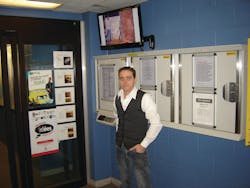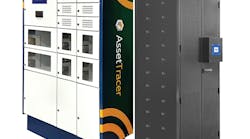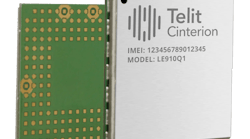Benoît Chaput has the job of overseeing the vehicles and technical gear used to operate Société Radio-Canada (SRC), the French language counterpart of the Canadian Broadcasting Corp., with headquarters in Montreal. The network produces more than 4,000 hours of programming a year, including radio, TV and Internet content. Chaput works in a huge warehouse that houses an array of broadcasting gear, from cameras to microphones, to lighting fixtures and other technical gear needed for live TV broadcasts, news interviews and other activities. He also oversees the network's vehicle fleet, about 85 vehicles including 5-ton trucks used to transport technical gear, vans modified to enable live broadcasts and even rental cars.
Keeping it all safe, secure and available at a moment's notice is a challenge in the fast-paced, 24/7 world of broadcasting. It is also a challenge that involves a lot of keys. In addition to vehicle keys, Chaput keeps track of office door keys, technical equipment locker keys and keys to maintenance tools, including a machine that provides high water pressure used to wash vehicles in the garage. There are currently 208 keys in all.
At one time, the technical gear warehouse kept keys on a pegboard almost like an old-style hotel front desk. Keys could not be distributed or returned after regular business hours, and employees often had to find security personnel to open the warehouse. Although there was a written log kept during office hours, it was never the same clerk and signatures were hard to read. No one knew who had what keys or how many hours a car was being used or by whom. Chaput described the situation as “chaos.”
Every Key Has a Slot
Since 2009, technology has solved the problem of keeping up with keys at SRC, thanks to an integrated key control and management solution provided by Morse Watchmans and sold by Morse Canada Systems Inc. Each key is attached by a stainless steel locking ring to a keyfob that incorporates an identification chip, which is inserted into a keyslot in the KeyWatcher electronic key cabinet. Users can only access keys with a proper user code. SRC uses three six-module, 96-key systems, providing a total of 288 keyslots.
Reservations at SRC for vehicles or equipment are handled by e-mail. Anyone needing access to equipment merely mails a generic account with their name and the date and hours they need the equipment. A clerk answers back with the number of the cabinet slot where the requested key will be located. The key system is located in an open hallway and is accessible at any hour. Each key has a four-digit number, and some of the numbers match numbers assigned internally to identify vehicles and equipment.
“We haven't lost a key since 2009,” Chaput says. “When we installed the KeyWatcher system, the first idea was to know who had each key and when they took it, which we didn't know before. When we got the system, we immediately saw many other good attributes.”
For example, installed software compiles information from the system on key usage and can run activity reports and sort data based on various criteria. Practical management reports can trace key movements by time, date and user code. An audit trail report indicates the time and date of every key accessed by a user for a given time parameter. At SRC, the information can be used to identify who left personal effects in a vehicle or who did not take the time to fill up the gas tank. Now, it is clear who was driving a vehicle, for example, when it was caught running a traffic light by an automated camera or who received a speeding ticket.
Greater Accountability
Employers in Canada must ensure each employee operating a vehicle has a valid driver's license, and now this can be verified before access to the key system is granted. Employees access the cabinet using the same proximity card they use to open the doors when they access the building. The ability to register users and provide access using a proximity card (instead of requiring a keypad PIN number) were important features for SRC, Chaput says. Another benefit of the system is availability of the software and supporting materials in French, which was not offered by competitors.
Of the 3,000-plus employees at the SRC Montreal headquarters, some 1,078 are registered system users. They include television and maintenance technicians, technical directors, reporters, administration staff and television personalities.
Using an electronic key control system has enabled SRC to maximize the use of its resources. For example, when previously a car might be used “all day,” now it is possible to schedule usage more precisely. If three hours is long enough, the car is then free for use later in the day by another employee. “We are able to do more with the same amount of resources,” said Chaput. “We now monitor much more closely how our resources are used.”


